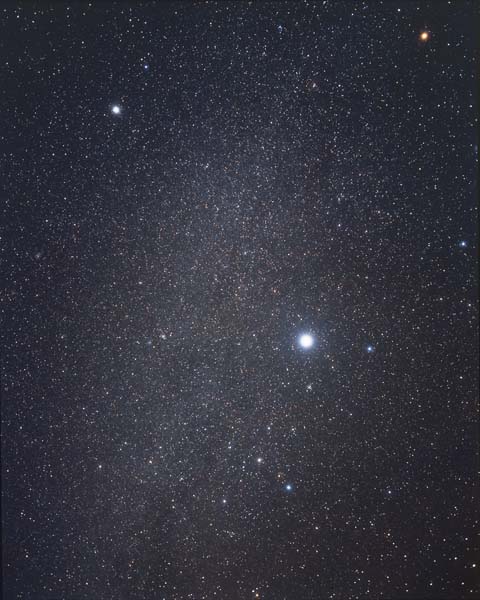DMI image reference Mon_2. « Previous || Next » Constellations A » H || Constellations I » V

Roll mouse over picture to see constellation outlines
Image and text ©2008 Akira Fujii/David Malin Images.
In the picture above north is at the top and the image covers 43.1 x 53.9 degrees.
Image centre is located at 07:11:33.8, -13:07:31 (H:M:S, D:M:S, J2000) Astrometric data from Astrometry.net.
Best seen in the early evening in January
Monoceros (the Unicorn) represents (yet another) mythical creature set among the stars. This one has the forelegs and (horned) head of a horse, the hindquarters of a stag and the tail of a lion. Such creatures are sometimes seen in Assyrian (~2500-600 BCE) carvings, and have been interpreted as originating in traveller's tales of the Indian or African rhinoceros.
The modern constellation sits astride both the Milky Way (and thus the Galactic equator, not shown) and the celestial equator. It is also enclosed on three sides by the bright stars of the Winter Triangle (Sirius, Procyon and Betelgeuse). Of course this refers to the northern hemisphere winter; these stars are equally visible in the southern summer and make Monoceros easy to find. However, the stars within the constellation itself are rather faint, and though they can be joined up produce a figure resembling a unicorn, none have common names. The famous Rosette nebula is just visible in the only closed triangle of the constellation figure.
Puppis (the Stern) is the largest of the four constellations that were constructed out of the great vessel Argo Navis. The original division was made by Nicolas Louis de Lacaille in the 1750s, but it was formalised by the International Astronomical Union in the 1930s. Argo Navis was the only one of Ptolemy's original 48 constellations that the IAU did not accept. Unfortunately we do not have a detailed image of the complete constellation, but parts can be found on Antlia, Carina, Canis Major, Horologium as well as in full on Argo Navis.
Main named stars in this image (Greek alphabet)
Asmidiske (ξ Pup), Adara (ε CMa), Alnilam (ε Ori), Aludra (η CMa), Betelgeuse (α Ori), Gomeisa, (β CMi), Muliphen (γ CMa), Murzim (β CMa Procyon, (α CMi), Saiph (κ Ori), Sirius (α CMa), Wezen (δ CMa).
Constellations adjoining Monoceros
Canis Major, Canis Minor, Gemini, Hydra, Lepus, Orion, Puppis.
Constellations adjoining Puppis
Canis Major, Carina, Columba, Hydra, Monoceros, Pictor, Pyxis, Vela.
Related images in Monoceros (see also under 'Related Images' on pages the below)
AAT 13. The Cone nebula in the NGC 2264 cluster in Monoceros
AAT 14b. The Fox Fur nebula and S Monocerotis
AAT 3. The Henize 70 nebula in the LMC
AAT 35. The Rosette nebula and NGC 2264 in Monoceros
AAT 79. NGC 2346, a planetary nebula in Monoceros
AAT 91. Trumpler 5, an old open cluster
AAT 96. NGC 2261, Hubble's variable nebula in Monoceros
UKS 9. The Rosette nebula and open cluster NGC 2244 in Mon.
UKS 29. The Cone nebula and Trumpler 5 in Monoceros
Related images in Puppis (see also under 'Related Images' on pages the below)
AAT 71. The head of cometary globule CG 4 in Puppis
AAT 107. NGC 2437-8, planetary nebula in open cluster.
AAT 113. M93, NGC 2447, an open cluster in Puppis
AAT 115. Random starfield in Puppis